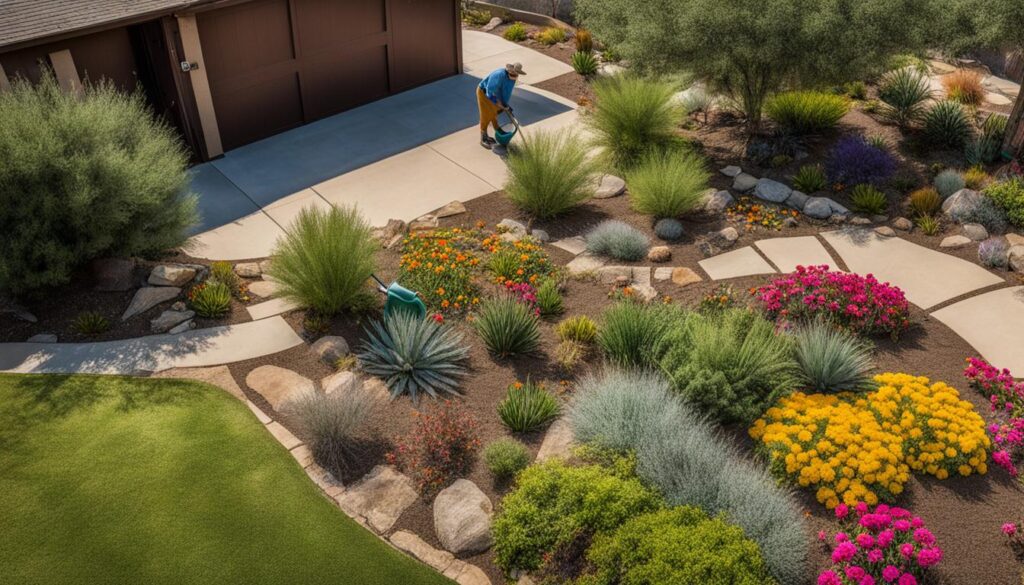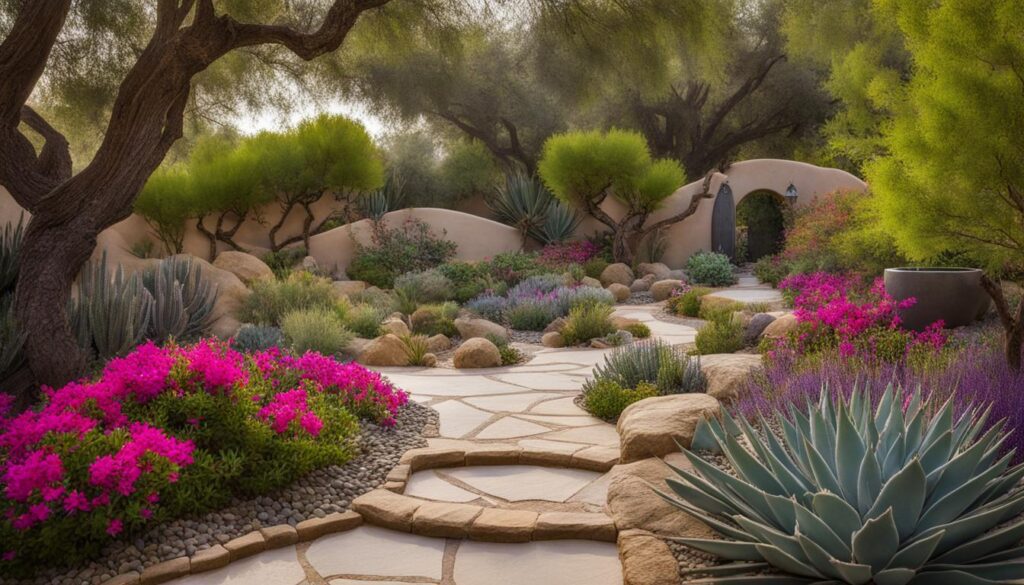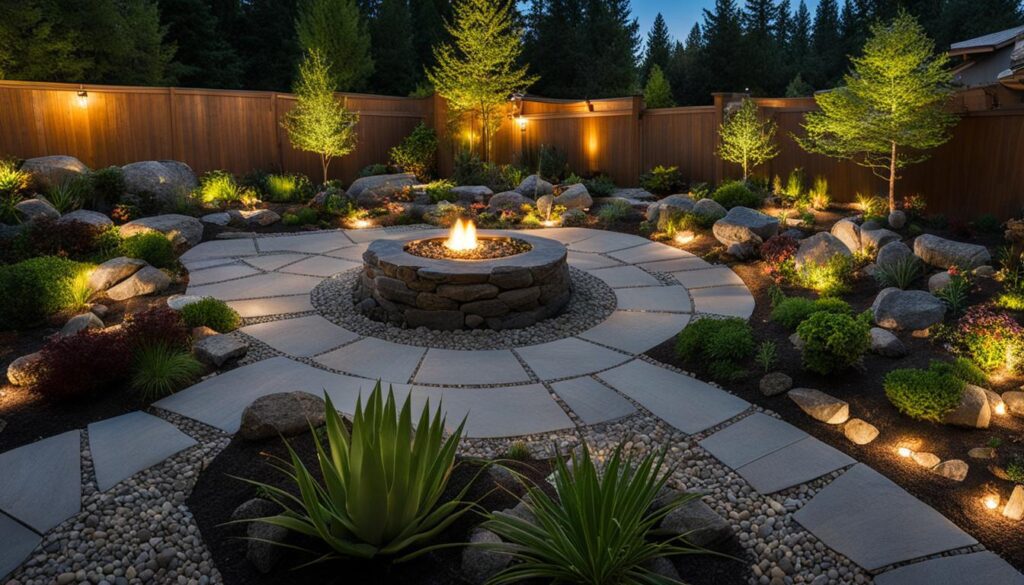Are you looking to transform your backyard into a beautiful and eco-friendly oasis? Look no further than native xeriscape designs. By incorporating elements like native plants, mulch, rocks, and water-wise pathways, you can create a stunning landscape that not only enhances the beauty of your outdoor space but also promotes water conservation and requires minimal maintenance.
Key Takeaways:
- Xeriscape designs use native plants, mulch, rocks, and water-wise pathways to create low-maintenance and eco-friendly backyards.
- By choosing native plants, you can ensure that your garden thrives in the local climate with minimal watering needs.
- Mulch helps retain moisture in the soil and reduces weed growth, while rocks add aesthetic appeal and trap moisture in the ground.
- Water-wise pathways collect rainwater and promote eco-friendly practices, while rock gardens create focal points with drought-resistant plants.
- Overall, native xeriscape designs offer a sustainable way to beautify your backyard while conserving water resources.
Benefits of Xeriscaping for Backyards
Xeriscaping offers numerous benefits for your backyard. By implementing this eco-friendly landscaping concept, you can conserve water, enjoy low maintenance requirements, and even save on costs. Let’s explore the advantages of xeriscaping in more detail.
Water Conservation
One of the key benefits of xeriscaping is water conservation. By using native plants that are well-adapted to the local climate, you can significantly reduce your irrigation needs. Native plants are often drought-tolerant, meaning they require minimal watering once established. This not only helps preserve water resources but also reduces water bills.
Low Maintenance
Xeriscaping is known for its low maintenance requirements. By incorporating plants, mulch, and rocks that are well-suited to your region, you can minimize the need for constant watering, mowing, and pruning. This not only saves you time and effort but also allows you to enjoy a beautiful backyard without the stress of high maintenance.
Cost Savings
Implementing xeriscaping techniques can lead to cost savings. With reduced water consumption, you’ll see a decrease in your water bills. Additionally, the low maintenance nature of xeriscaping means you’ll spend less on landscaping services and equipment. Over time, these cost savings can add up, making xeriscaping a financially rewarding choice.
By embracing xeriscaping in your backyard, you can reap the benefits of water conservation, low maintenance, and cost savings. It’s a sustainable landscaping approach that not only supports a greener environment but also enhances the beauty and functionality of your outdoor space.
| Benefits | Brief Description |
|---|---|
| Water Conservation | By using drought-tolerant native plants, xeriscaping reduces irrigation needs and helps preserve water resources. |
| Low Maintenance | Xeriscaping reduces the need for constant watering, mowing, and pruning, resulting in a low maintenance backyard. |
| Cost Savings | With reduced water consumption and lower maintenance requirements, xeriscaping can lead to cost savings on water bills and landscaping services. |
Choosing Native Plants for Xeriscape Designs
When designing a xeriscape garden for your backyard, it is important to choose native plants that are well-adapted to the local climate and require minimal watering. Native plants are often drought-tolerant and can thrive with little maintenance. Consider selecting a variety of native plants such as succulents, ornamental grasses, and flowering perennials to create a diverse and visually appealing xeriscape garden.
Native plants have evolved to withstand the local climate conditions, making them a perfect choice for xeriscape designs. They have already adapted to the amount of rainfall, temperature, and soil conditions in your region, which means they will require less water compared to non-native plants. Additionally, native plants are more resistant to pests and diseases, reducing the need for harmful chemical treatments.
When choosing native plants for your xeriscape garden, consider their water needs and growth habits. Drought-tolerant plants like agave, lavender, and yucca are excellent choices as they can survive long periods without water. Ornamental grasses, such as feather grass and blue grama grass, add texture and movement to your xeriscape garden while requiring minimal watering.
Remember to select plants that bloom at different times of the year to ensure year-round color and interest in your xeriscape garden. Native flowering perennials like black-eyed Susan, purple coneflower, and California poppy are not only beautiful but also attract pollinators to your garden. Their deep root systems help improve soil health and prevent erosion.
By choosing native plants for your xeriscape garden, you can create a sustainable and low-maintenance landscape that conserves water and supports local ecosystems. The diverse range of native plant options allows you to design a visually stunning xeriscape garden while promoting environmental stewardship. Take the time to research and select native plants that are well-suited to your region, and enjoy the beauty and benefits of a thriving xeriscape garden.
Incorporating Mulch and Rocks in Xeriscape Designs
Mulch and rocks are essential elements in xeriscape designs, offering both practical and aesthetic benefits. By incorporating these elements into your backyard, you can create a sustainable and visually appealing landscape that conserves water and promotes soil fertility. Let’s explore how mulch and rocks can enhance your xeriscape design.
Benefits of Mulch
Mulch plays a crucial role in xeriscape designs by helping to retain moisture in the soil. By creating a protective layer over the soil surface, mulch reduces evaporation and prevents water loss. In addition to water conservation, mulch also suppresses weed growth, providing a natural and low-maintenance solution for weed control. Furthermore, as organic mulch breaks down over time, it enriches the soil with nutrients, improving soil fertility and promoting healthy plant growth.
Utilizing Rocks for Water Conservation
Rocks are another vital component of xeriscape designs, offering several benefits for water conservation. When strategically placed, rocks can help minimize evaporation by providing shade and reducing direct exposure to sunlight. They also act as a natural barrier, trapping moisture in the ground and preventing runoff. Additionally, rocks add aesthetic appeal to your xeriscape design, creating texture, contrast, and visual interest. Select rocks that complement the overall theme of your xeriscape design, considering their size, shape, and color.
| Mulch | Rocks |
|---|---|
| Retains moisture in the soil | Minimizes evaporation |
| Suppresses weed growth | Traps moisture in the ground |
| Improves soil fertility | Adds aesthetic appeal |
Incorporating a combination of mulch and rocks in your xeriscape design can maximize the benefits of both elements. Use mulch around plants to conserve moisture and control weeds, while strategically placing rocks to create focal points and enhance water conservation. Remember to consider the specific needs of your plants and the local climate when choosing the type and thickness of mulch, as well as the size and arrangement of rocks in your xeriscape design.
With the incorporation of mulch and rocks, your xeriscape design can not only create a vibrant and sustainable backyard but also contribute to water conservation efforts. By utilizing these elements effectively, you can achieve a visually appealing landscape that is low-maintenance, eco-friendly, and promotes soil fertility.
Designing Water-wise Pathways in Xeriscape Gardens
Xeriscape gardens are known for their water-saving and eco-friendly features. One important aspect of designing a xeriscape garden is creating water-wise pathways. These pathways not only provide functional walkways but also contribute to the overall sustainability and aesthetic appeal of your backyard.
When designing water-wise pathways in your xeriscape garden, consider incorporating rainwater collection techniques. By creating pathways that allow rainwater to reach the soil, you can maximize water conservation efforts. Avoid using compact concrete walkways, as they prevent rainwater from penetrating the ground. Instead, choose permeable materials such as pavers with spaces between them or overlaid pavers on crushed stone. This allows rainwater to seep through and nourish the soil, reducing the need for additional irrigation.
Benefits of Water-wise Pathways:
- Maximize rainwater collection and minimize water runoff
- Reduce the need for supplemental irrigation
- Promote healthy soil moisture levels
- Create a visually appealing and eco-friendly garden
In addition to rainwater collection, another consideration for water-wise pathways is the use of gravel. Gravel paths are cost-effective alternatives that allow rainwater to permeate the soil easily. Choose gravel with a size and color that complements your xeriscape design. Not only does gravel provide a natural and rustic look, but it also helps retain moisture in the soil, reducing the need for watering.
“Water-wise pathways not only contribute to the sustainability of your xeriscape garden but also enhance its beauty. By incorporating rainwater collection techniques and using permeable materials like pavers or gravel, you can create a pathway that conserves water and adds an eco-friendly touch to your backyard.”
Designing water-wise pathways in your xeriscape garden is an opportunity to integrate sustainable practices and make a positive impact on the environment. By allowing rainwater to nourish the soil and reducing the need for supplemental irrigation, you can create a beautiful and water-wise oasis in your backyard.
Creating Focal Points with Rock Gardens
Rock gardens are a popular choice in xeriscape designs for creating focal points in the backyard. These unique landscapes combine the beauty of rocks with the resilience of drought-resistant plants, resulting in a visually stunning and low-maintenance garden. By strategically placing boulders and rocks, you can add a touch of natural elegance to your xeriscape design.
Drought-resistant plants are the perfect companions for rock gardens. Cacti, succulents, and groundcovers are excellent choices that can thrive in rocky areas with minimal water requirements. Their ability to withstand dry conditions and extreme temperatures adds to the overall resilience of the rock garden.
Cascading ground covers like creeping thyme and creeping phlox can be planted between the rocks to create a lush and vibrant look. These low-growing plants not only soften the harsh edges of the stones but also provide a burst of color and texture. The combination of rocks and drought-resistant plants in a rock garden creates a focal point that is both visually striking and environmentally friendly.
The Key Elements of a Rock Garden
When designing a rock garden, consider the following elements to ensure its success:
- Placement and Size: Position the rocks in a natural-looking arrangement, considering their size, shape, and color. Varying the placement and size of the rocks will create visual interest and mimic the organic beauty of nature.
- Plant Selection: Choose drought-resistant plants that can thrive in rocky conditions. Opt for a mix of colors, textures, and heights to create an eye-catching display.
- Soil and Drainage: Ensure proper soil composition and drainage to prevent waterlogging and root rot. Use well-draining soil and consider adding gravel or sand to improve drainage.
- Maintenance: Rock gardens require minimal maintenance. Regularly remove weeds and debris, and prune plants as needed. Monitor the health of the plants and provide supplemental water during periods of extreme drought.
By following these guidelines, you can create a captivating rock garden that becomes the focal point of your xeriscape design. The combination of rocks, drought-resistant plants, and careful design will result in a visually stunning and water-wise backyard oasis.
Can I Use the Xeriscaping Basics for Residential Landscapes in My Backyard?
Yes, you can absolutely use xeriscaping basics for landscapes in your backyard. By implementing principles such as drought-tolerant plants, efficient irrigation, and minimal turf grass, you can create a beautiful and sustainable residential landscape that conserves water and requires minimal maintenance.
Conclusion
Native xeriscape designs are the perfect solution for transforming your backyard into a beautiful and eco-friendly oasis. By embracing these low-maintenance designs, you can not only create a stunning landscape but also contribute to water conservation efforts.
With the use of native plants, you can ensure that your backyard thrives in its natural environment, requiring minimal watering and maintenance. These plants are well-adapted to the local climate, making them resilient and sustainable choices for your xeriscape garden.
By incorporating mulch and rocks into your design, you can further enhance water conservation efforts. Mulch retains soil moisture, reduces weed growth, and improves soil fertility, while rocks help trap moisture and add aesthetic appeal. Together, these elements create a visually appealing and sustainable landscape.
Lastly, by designing water-wise pathways and rock gardens, you can create focal points that not only add beauty to your backyard but also promote eco-friendly practices. These pathways allow for rainwater collection and permeability, while rock gardens provide a home for drought-resistant plants, bringing life and vibrancy to your xeriscape design.














